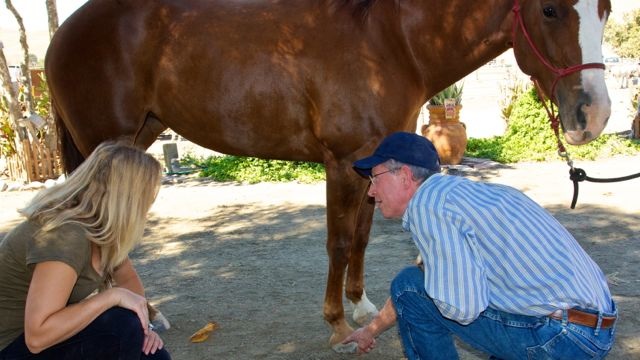 Building a clientele you enjoy
Building a clientele you enjoy
Most of us choose to become farriers because we wanted the independence a life with horses brings. A business that offers a choice of location, environment, clientele, the hours we work and the income we earn. After all, what better way to earn a living than with horses. You started out giving your hoofcare business direction.
But even that dream has its drawbacks …
Eventually, we get tired, overworked or frustrated with our client’s foolishness and seek a change to get relief.
Or, as our expertise grows we see new challenges and possibilities to increase our income.
Or, as we get older and our physical ability changes, we need to slow down.
A change of business direction is an evolutionary process
Whether you’re just starting out or are a veteran hoofcare specialist, a change in businesses focus is something you can count on …
Every change comes with an adjustment in clientele …
and it can work to our advantage!
When we started in business, we designed it the way we wanted, the way we thought it worked best. As we gained experience we adapted our business.
Some changes are for the better and some not. Building our business can happen by chance or it can be deliberate. In my own experience, it’s happened 7 or 8 times and I’m sure has more to go.
The best results came through knowing what I wanted, planning and being deliberate in selecting my clientele. So they win, the horse wins and I win.
This of course allows my choice of location, work environment and income.
Giving your hoofcare business direction …
The building blocks of creating a deliberate change
Planning
At this stage, you can’t go wrong. You’re playing with ideas to come up with a practical plan.
To get a clear picture of what you want your business to look like, ask a series of questions and begin answering them.
- What type of people do you want to work for?
- What types of horses do they have and where are they kept?
- What activities does the rider engage in?
- What types of problems and concerns do these people have about hoofcare and where do they seek advice?
- What problems do the horses have?
You’re beginning to identify your ideal client. The more you know about and understand them, the easier it is to tailor a message to them.
- What type of work do you want to do?
- Do you have the knowledge and skills necessary to do this kind of work?
- How long will it take to acquire the skill?
- Who can help accelerate the process??
- Where do you want to work?
- How much do you want to work?
- How many days per week, and how many horses each day?
- How much do you want to earn?
This will give you an idea of how many clients and horses you need, how much to charge, if your targeted clientele can afford you and if the area can support you.
Evaluate your plan Be bold and creative. This is just on paper.
Is this practical? Or do you need to make some adjustments so it’s feasible. Adjust the picture.
When you find a scenario of your plan you think will work it’s time to begin laying the foundation.
Execute the plan Visibility — Credibility
To begin attracting your ideal client, you need to be seen while establishing your credibility and expertise in being able to solve their hoofcare problems. There are several ways to do this.
- Write articles about your area of expertise for the publications your clientele reads and put up a website or blog with articles addressing their concerns. If you have success stories spotlighting your new business direction ask for testimonials and use them in the articles (it’s more believable when someone else toots your horn). When you focus the articles and testimonials in the direction you want your business to grow, it will begin attracting the attention of the clientele you want.
- Begin going to places your target group frequents. Certain barns, shows, events, sales etc. Your goal is to be visible to to this group of people. Find them and start making friends. Offer helpful insights and advice for free before ever asking for their account. If they need a shoe adjusted or foot cleaned up, do it with a smile. Be friendly and likable; people like doing business with people they enjoy and respect. Get people talking about you. People want to reciprocate when someone has given them something or helped. This is the start of the word of mouth marketing to expand your reputation.
- Do the best job you can on every horse and continue helping people solve their hoofcare problems.
Marketing Actions speak louder than words
- By giving you hoofcare business direction, it’s easy to create a clear message about what you do.
- Present the message through your actions so potential clients see the benefit of working with you.
- Your work, actions, the articles you write and your website are the perfect vehicle to do your marketing.
- Offer something for free to people interested in what you’ve written about in exchange for their contact information. This allows you to follow up, keeping them interested and allowing them to help spread the good word about you.
Client acquisition process
- Marketing and client acquisition are not the same. Marketing is letting people know about you and getting them interested, but you don’t want just anyone as a client.
- You want the specific profile you described earlier … clients that will propel your business in the direction you want it to grow.
- The client acquisition phase is where you evaluate and select new clients.
- This is a very important step … choosing clients who aren’t a good fit is counterproductive and slows growth.
Put some mental muscle to designing this process.
- Know as precisely as possible what you want your business to be like. Decide who your ideal client is and how you’ll recognize them.
- From this list, develop some specific questions to provide valuable insights. Most of us do this already. We can tell if we want to work with a person within the first minute of the initial phone call. The goal here is to be very specific in the questions you ask. Ask leading questions as the potential client will be presenting themselves in their best light. One way to do this is to have a screening process that prospective clients go through on your website. If they pass that stage, call them … if not, they get an email saying you’re not taking on clients at the moment. This makes you exclusive with the perception of being hard to get … making people want you more.
- From these questions, develop an interview process each client will go through. Refine it over time.
- When a prospect passes the question part of the interview, tell them about the next step.
- Propose an evaluation appointment. Explain that to work well together we need to see if we’re a good fit … and we need to see if I can indeed help your horses as you desire. Explain the fee for the evaluation and what to expect.
- If they accept the evaluation appointment, set it up.
- There are two aspects to the evaluation.
A) Talk about what you expect from the client and what they can expect from you. Ask if that’s acceptable.
B) Gather information and ask questions about the horse, commenting on your observations. Describe what needs to be done and whether you are the one to do it.
- Ask what they want to do.
If they make it through the interview and evaluation process you have found a client you can work with, a horse you can be successful with and they are more committed to the process because of the time and energy invested in getting you to work with them.
We have a choice in what our business will look like, and how we operate. How successful we are depends on how clearly we know what we want, plan for it and then execute the plan.
Time spent in planning can be some of your most profitable.
Are you giving your hoofcare business direction?
Want help giving your hoofcare business direction? Write your biggest problem or concern in the comments below and I’ll address it in a future post.
Here’s to your successful farrier business!
We promise never to spam.

{ 0 comments… add one }
You must log in to post a comment. Log in now.